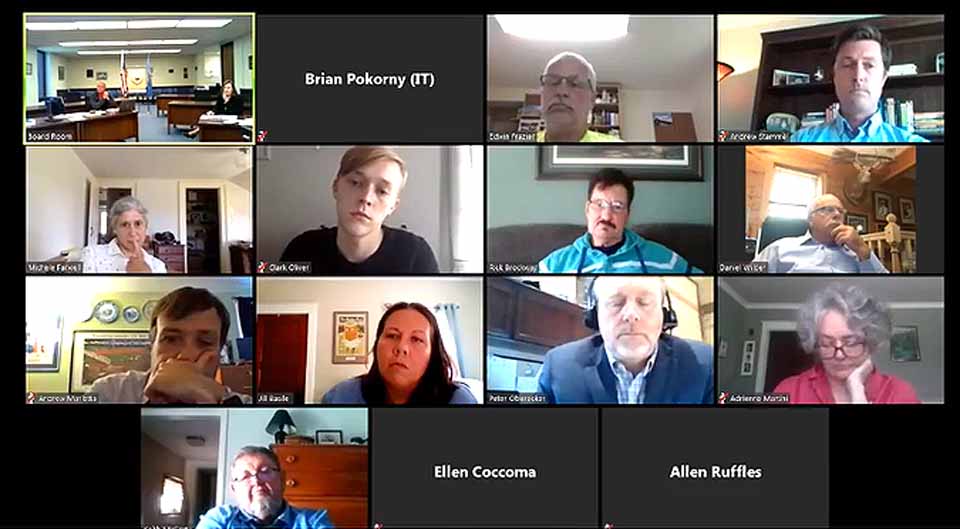59 LAYOFFS
ENACTED BY
COUNTY REPS
Union Rejects ‘Olive Branch’
As Board Seeks To Ease Pain

By JIM KEVLIN • Special to www.AllOTSEGO..com
 COOPERSTOWN – After a 2½-hour executive session, the Otsego County Board of Representatives emerged this afternoon to vote, 9-4, with one absence, to lay off 58 employees, saving $1 million in the face of plummeting revenues caused by the coronavirus threat.
COOPERSTOWN – After a 2½-hour executive session, the Otsego County Board of Representatives emerged this afternoon to vote, 9-4, with one absence, to lay off 58 employees, saving $1 million in the face of plummeting revenues caused by the coronavirus threat.
The meeting, the second this month, was called specifically to decide on layoffs.
Four Democratic county representatives voted nay: Michele Farwell, Gilbertsville; and three Oneontans, Andrew Stammel and freshmen Clark Oliver and Jill Basile. Danny Lapin, D-Oneonta, had participated in the Facebook Live meeting, but was absent for the vote.
But it was not a strictly partisan vote: Democrats Andrew Marietta, Fly Creek, and Adrienne Martini, Oneonta, joined six Republicans and Conservative Meg Kennedy, R-Hartwick, in approving the layoffs.

Speaking with the ayes, Peter Oberacker, Schenevus, who is also running for state Senate, quoted Teddy Roosevelt: “In any moment of decision, the best thing you can do is the right thing. The next best thing you can to is the wrong thing. The worst thing you can do is nothing. Sometimes the hardest thing and right thing are essentially the same.”
Oberacker added, “This decision is one of the hardest we’ve ever made. But it’s the right thing for the other 60,000 people we represent.”
On the other side, Stammel, the most senior of the nays, said, “We all had to search our own consciences. I needed to tell my own self: This truly was a last resort … And I’m not confident in saying that at this point.”

He objected to the 15 percent cut in “outside agencies,” Destination Marketing Corp. of Otsego County in particular, which saw its $600,000 allocation to promote tourism – and thus raise sales- and bed-tax revenues – reduced to $500,000.
“I need to tell myself, this is truly the last resort. And I’m not confident in saying that at this point,” he continued. “Our employees are the one who are doing our core mission. The agencies are not doing our core mission: that’s why they’re called ‘outside agencies.’”
In the end, that resolution – “outside agencies” also covers the two chambers of commerce, Cooperative Extension and libraries – was returned to the Administration Committee for further review.
• RUFFLES OUTLINES SITUATION

As the five-hour meeting began, County Treasurer Allen Ruffles estimated the budget gap, caused in large part in the bottom falling out of the sales- and bed-tax revenues, at $12 million. A hiring freeze and other measures have saved $4 million so far.
He reported talking to another county treasurer, who said counties that do not make cuts now will be bankrupt in four months.
The layoffs are “a temporary cut that puts a tourniquet on the bleeding,” said Ruffles, a metaphor that was picked up later when reps delivered final arguments.
“Let’s reorganize this county, let’s create efficiencies, let’s do whatever we can,” he said, “and be hopeful to bring these people back. Let’s look optimistically at this.”
ׇ• EMPLOYEE UNION WON’T BUDGE
The layoffs are happening soon enough that employees furloughed will receive the $600 a week federal supplement to normal unemployment benefits.
The county board sought to lighten the burden further by – contrary to its contract with the CSEA – allowing laid-off employees to keep medical benefits through the end of the year, and to return with their seniority and vacation benefits intact.
During the meeting, however, County Attorney Ellen Coccoma received a call from the CSEA rejecting the county’s generosity. Later, the representatives unanimously passed a resolution detailing the offer and saying it is still available if the union changes its mind.
Personnel Director Penny Gentile reminded the board that the sweetened benefits were “an olive branch” offered to the union; under Civil Service law, laid off employees would lose vacation, seniority and health benefits.
• WHAT DID DEPARTMENT HEADS DO?
In his presentation, Ruffles emphasized the cuts were made by department heads in three rounds of conversations, not the county board. “They know their departments. They know how to run their departments. I’m going to trust them,” he said.

However, Lapin, a member of the Health & Education and Solid Waste & Environmental Concerns committees, said department heads – in Health and Planning & Solid Waste – are concerned about “the functionality of that department.”
“Did you hear it from the department head?” asked Gentile, “or did you hear it from someone else. Because we worked closely with the department heads.”
“The department head, correct,” said Lapin.
That prompted a call from county Planning Director Karen Sullivan to county board Chair Dave Bliss, R-Cooperstown/Town of Middlefield, who later said Sullivan affirmed Gentile’s version over Lapin’s understanding of the situation.
The issue was apparently discussed in the lengthy executive session, as county Rep. Ed Frazier, R-Unadilla, on exiting, amended Ruffles’ statement:
“We required department heads to come back to us,” he said. “This is on the county board, not on the department heads. When we said these were their recommendations, we required department heads to come back to us.”
Ruffles re-characterized his original comment: “They did not recommend, they consulted with us. They didn’t want to do this any different than anybody else.”
• THE FOCUS: THE 58 LAYOFFS
The 59 layoffs, however, were on center stage, with the representatives emphasizing this was the most difficult decision many of them had to make.
A sampling:
-

Representative McCarty, the longest-serving board member, said today’s decision was the hardest he’s ever made. Keith McCarty, R-East Springfield, the longest serving board member, said today’s decision was “100 times worse” than cuts made after in the Recession of 2008. “I apologize to all the workers for this … I’m not happy about this, but I think we need to do it.”
- Farwell, who would later vote nay, called today’s action “our responsibility, our fiduciary responsibility, but responsibility to our employees, to our constituents.” But, she added, “I feel we haven’t done every possible thing, and I can’t get behind this today.” Oliver and Basile agreed.
- Rick Brockway, R-Laurens, said, “Laying people off is the hardest thing. My wife lost her job in August. I know how this is. We just can’t do nothing. If we don’t start cutting someplace, we’ve lost entirely.
- Dan Wilber, R-Burlington, said, “If we truly believe there are other places to cut, we need to do our homework … We have 10 days (by June 1) to come up with cuts to equal these cuts.”
ׇ• A MATTER OF PAYING THE BILLS
After the meeting, Bliss said he was not surprised by the 10-4 vote. A lot of information had been distributed to board members in advance, and he had a sense of how the individual reps were leaning.
At the meeting, he pointed out there have already been cuts, the fire-training center, the highway budget, “but it’s not enough. We need to cut $15 million to break even. This is just a little less than a million of the necessary amount.”
Ruffles, with Kennedy agreeing, said while things like eliminating the training center help the county’s position long term, “the county needs cash soon to meet its responsibilities.”
“The layoffs are a matter of cash flow, of money in the bank,” he said.


The extra $600 per week under the Fed unemployment bill will ease the shock of those laid off. Use your vacation wisely .
Were across the board furloughs considered? I retired from the University of California system and we endured partial furloughs whenever the state budget was in crisis. Reducing everyone’s time by the same 10% was a more equitable method of spreading the pain, and it enabled employees to easily return to full-time hours once the budget allowed. Management usually ended up working full-time hours and only being paid 90%, but that was part of being in management.